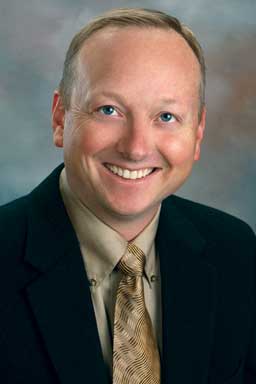President’s message: If you’re going to go, you have to be prepared to leave… (Nov 2010)
I believe we underestimate the unique and valuable training we receive in veterinary college to be broad-based thinkers – real jacks-of-all-trades in service to animals for better health and production. You say it’s coughing? I can handle that, no problem… Diarrhea? Bring it on… The pigs are tail biting? Let’s get started… In fact, veterinary medical training prepared me for parenthood. A skinned knee? Come here, Bud, and let’s take a look… Nervous about the new school year? How about a bowl of ice cream to cheer you up… You broke up with your boyfriend? Aw, Punkin’, he was a bum anyway – now why don’t you go talk to your mother… So when my son came to the sideline with a bloody nose during the football scrimmage, I walked over from the end of the field and gave him a tissue, showed him where to apply pressure, and reminded him to keep his head level. The host school’s trainer came by, noticed the problem, and said, “I’m a trainer – I’ll take care of it – that’s what I’m here for.” “Oh, I’m sorry,” I told her, “He’ll be fine – I’m a veterinarian.” Of course she didn’t know I was also his father; evidently, I had encroached on her turf. As she did a 180° to go to a cart of supplies for a wet towel to clean up the blood, another parent heard her mumble, “Gee, I guess next time we’ll just bring a vet!”
Yes, we pig veterinarians are equal-opportunity problem solvers – we tend to annoy everyone! But the passion shared among our membership for keen observation, diagnostic investigation, and strategic thinking is largely why we’re still hanging out together at AASV meetings after more than 40 years. There are questions yet to answer! Our mission statement clearly describes how the AASV works to “increase the knowledge of swine veterinarians”:
- Promoting… resources which enhance the effectiveness of professional activities;
- Creating opportunities which inspire personal and professional growth;
- Advocating science-based approaches to industry issues;
- Encouraging personal and professional interaction;
- Mentoring students, encouraging life-long careers as swine veterinarians.
Is this enough? The past several years have demonstrated that animal agriculture and food-animal veterinary care are under attack. As we all know, animal activist groups are clamoring for dramatic changes in animal-care standards, housing, treatment options, and harvest. Other groups work to restrict our access to tools and technologies that have proven important to the health and well-being of farm animals and the production of safe food. The leadership of veterinary associations at the state and national levels feel increasing pressure from some members to stand with the activists in support of regulations that go well beyond common sense and the practical ability of farmers and food-animal veterinarians to comply. What should AASV’s role be in this battle of knowledge and values?
As individuals, many of our members already give significant time and resources to promote our swine veterinary profession and have been strong advocates for science-based decisions. The knowledge and skills of AASV members willing to speak to public-policy issues is improving through participation in National Pork Production Council’s Swine Veterinarian Advocacy Program. Members of the AASV are on American Veterinary Medical Association committees and serve in its House of Delegates and in other leadership positions where they work diligently to engage fellow veterinarians in areas where we can agree to shared principles. Dr Harry Snelson does a yeoman’s job to stay abreast of issues in Washington, DC, and across the industry that influence our profession, and he communicates to our committees and membership with helpful insights. Even with all those important efforts, some members have suggested that the time is right to consider how we might participate more fully and effectively in the public-policy arena in order to advocate for science-based approaches and decision making on behalf of our members. Questions abound. How could this be structured? Does it mean creating a new organization? How would we raise funds to support this function in grassroots development and issues management?
The AASV is not alone in working to identify new avenues to have impact. Other friendly efforts are underway to address food-policy issues. One such group actively participating in the dialogue is the Center for Food Integrity (CFI).1 Its mission is to build consumer trust and confidence in today’s food system by sharing accurate and balanced information, correcting misinformation, modeling best practices, and engaging stakeholders. Managed by an independent board of directors, CFI is supported by a host of reputable groups. One specific purpose of CFI is to connect credentialed experts with the media in order to provide a balanced and credible voice in the public discussion of food-system issues. Collaboration with organizations such as CFI is consistent with the high standards of science-based professionalism central to our AASV mission statement. Are we prepared for such a new arm of outreach and advocacy?
I think Michelangelo would have made a great swine veterinarian. He once said “I hope that I may always desire more than I can accomplish.” Our dedication to pigs, people, and the benefit of society creates an opportunity for us to lead in shaping food-animal care. Are we ready to go?
–Paul Ruen, DVM
Reference
1. Center for Food Integrity. Available at: www.foodintegrity.org. Accessed 2 September 2010.
